 From the point of view of
historical traditions in Rajasthani painting the Mewar school occupies first
place. The artistic heritage of Medpat, the land of Guhil rulers, was a
perennial source of inspiration for ancient and other schools of art. Paintings
of Mewar earned wide publicity among other styles and substyles, and paintings
of the Udaipur, Nathdwara and Devgarh styles are immortal legacies of this
school.
From the point of view of
historical traditions in Rajasthani painting the Mewar school occupies first
place. The artistic heritage of Medpat, the land of Guhil rulers, was a
perennial source of inspiration for ancient and other schools of art. Paintings
of Mewar earned wide publicity among other styles and substyles, and paintings
of the Udaipur, Nathdwara and Devgarh styles are immortal legacies of this
school.
The preliminary and original
form of Rajasthani painting, which had emerged from a synthesis, is visible in
the Mewar school. Some artists and Guild rulers of Vallabhipur came to Mewar
and applied the Ajanta traditions with tremendous success. This tradition,
after having assimilated local features, maintained its original identity and
was known as the Mewar school of painting.
Historical
Background
When did the Mewar school of
Indian painting come into existence? Connoisseurs of art have speculated on
this point as great centres of art like Chavand and Chittor had time and again
been devastated in numerous onslaughts by enemies. Hence even today the history
of Mewar is shrouded in ignorance.
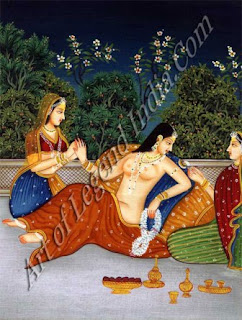 King Rana Kumbha (1443-1468)
was a keen student of architecture, literature, music and the other arts. That
this ruler was indifferent to painting is a view that does not seem acceptable,
but the history of painting in the 15th century remains in oblivion.
Rana Sanga (1509-1520) spent his life waging wars against the Mughal ruler
Babar.
King Rana Kumbha (1443-1468)
was a keen student of architecture, literature, music and the other arts. That
this ruler was indifferent to painting is a view that does not seem acceptable,
but the history of painting in the 15th century remains in oblivion.
Rana Sanga (1509-1520) spent his life waging wars against the Mughal ruler
Babar.
A great centre of the arts,
Chittor had been devastated in constant wars, and Udai Singh (1537-1572) made
Udaipur his capital because of its strategic location. Maharana Pratap
(1572-1597) never accepted the suzerainty of the Mughals and established
Chavand, situated in a mountainous region, as his capital. Chittor, Chavand and
Udaipur earned a great reputation as centres of early Mewari painting.
Amar Singh (1597-1620)
partially accepted the suzerainty of the Mughals, and for this reason the
impact of Mughal art on Mewar painting was significant, particularly in the
reigns of Karan Singh and Jagat Singh (1628-1652). Raj Singh (1652-1680),
having rejected the suzerainty of Aurangzeb, installed a statue of Shri Nathji
in Nathdwara and thus exhibited his deep devotion to the Vaishnav sect. The
Pushti sect began to influence Mewari art. Raj Singh, a keen lover of art, was
a Pushti margi, hence in his reign the arts flourished. Jai Singh (1680-1696)
and Amar Singh (1698-1710) provided a further impetus to Mewar art.
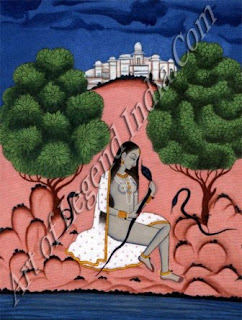 From these facts, the role of
Mewar in developing Rajasthani art from its very beginning is abundantly clear.
On the basis of researches, the first example of the Mewar style is the
pictorial text titled Shravak Pratikraman Churni, which was painted in Adhar
(Ahar-Udaipur) in 1260 in the reign of Guhil Tej Singh.2 Its decoration
resembles the intricate artistic workmanship of temples dedicated to Mokul in
Nagda, Udaipur and Chittor.
From these facts, the role of
Mewar in developing Rajasthani art from its very beginning is abundantly clear.
On the basis of researches, the first example of the Mewar style is the
pictorial text titled Shravak Pratikraman Churni, which was painted in Adhar
(Ahar-Udaipur) in 1260 in the reign of Guhil Tej Singh.2 Its decoration
resembles the intricate artistic workmanship of temples dedicated to Mokul in
Nagda, Udaipur and Chittor.
The distinct features of this
style include savachashma, a nose resembling an eagle's, eyes similar to
parvalli-fank, long figures and plentiful use of red-yellow colours. Examples
of it are referred to in Supasnah Chariyam, a pictorial text compiled and
painted at Devkulapatak (Dilwara) in the reign of Mokul around 1422-23 In that
text, the imprint of the Jain and Gujarati schools, along with the above-named
features of Rajashani painting, is clearly visible. In this style Kalpa-Sutra
(1426) deserves special mention. The style of its drapery resembles that of the
images of Vijay-Stambh of Kumbha.
For many centuries this pervaded
most of the painting in Western India in general and Mewar in particular. The
forts of Maharana Kumbha (Kumbhalgarh) and Kumbha Palace (Chittorgarh) possess
frescoes which depict the salient features of paintings of that age. Only faint
glimpses of these frescoes are now visible. In the 16th century,
Chavand, the capital of Maharana Pratap, earned the reputation of being a great
centre of art. In 1605, Rag-Mala was painted at Chavand with the impact of folk
art and the imprint of the Mewar style.' Nayak-nayika had a series painted in
1640 definitely in the Mewar style, and it also should the partial influence of
the Mughal style of the Jehangir period.
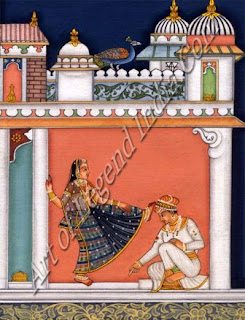 Painting Many pictorial texts
painted in the Mewar style in the middle of the 17th century and in the reign
of Maharana Jagat Singh (1628-52) are available. Because of the growth of the
Vallabha sect in Rajasthan, the Radha-Krishna Lila was the main contribution of
the Mewar style. Hence Bhagwad-Puran was the main subject of painting. In the
text of Bhagwad-Puran painted by Sahabadi (1648) and preserved in the
Bhandarkar Institute, Pune, the Maharaja of Jodhpur Museum and the National
Museum, fine examples of the Mewar style are available.
Painting Many pictorial texts
painted in the Mewar style in the middle of the 17th century and in the reign
of Maharana Jagat Singh (1628-52) are available. Because of the growth of the
Vallabha sect in Rajasthan, the Radha-Krishna Lila was the main contribution of
the Mewar style. Hence Bhagwad-Puran was the main subject of painting. In the
text of Bhagwad-Puran painted by Sahabadi (1648) and preserved in the
Bhandarkar Institute, Pune, the Maharaja of Jodhpur Museum and the National
Museum, fine examples of the Mewar style are available.
In this period of composing
poems with the Krishna-Lila legend as basis, paintings were created on a large
scale symbolic of the cult of Krishna-Bhakti in Mewar. Pictorial texts
concerning Sursagar, Rasikpriya, Rag-Mala, Ramayan are available in the Mewar
style. Scenes of the Ramayan painted in 1651 and preserved in the State Museum,
Udaipur, and paintings created by the artist Hon bar in 1649 and preserved in
the Prince of Wales Museum, Bombay, are also available. Many pictures painted
on the basis of stanzas of Sursagar are still available in the custody of Gopi
Krishna Kanodia, Calcutta, and in the private collections of Sangram Singh, Ram
Gopal Vijayavargia, Jaipur and National Museum, New Delhi.
The period of Maharana Jagat
Singh (1628-52) was the Golden Age of the development of Mss painting and other
arts. The paintings based on the Rain Charit and Krishna Chant are a valuable
art-heritage even now. Sahi Badeen and other talented painters gave a new life
to Mewari art.
 Maharana Raj Singh (1652-1681)
also maintained the tradition of his father. During his period, paintings based
on a number of Sanskrit-writings, books of Bliakti and Ritikaleen periods were
made in abundance. The paintings of Shukar Kshatra Mahatinnya made by the
famous painter Sahi Badeen in 1655 and Bhramar Geet Stir in 1659, a few leaves
of which are preserved in the National Museum, New Delhi, hint at the evolution
of Mewar style. A few pages of Geet Govind set painted during this period,
preserved in Govt. Museum, Udaipur, are exceedingly artistic.
Maharana Raj Singh (1652-1681)
also maintained the tradition of his father. During his period, paintings based
on a number of Sanskrit-writings, books of Bliakti and Ritikaleen periods were
made in abundance. The paintings of Shukar Kshatra Mahatinnya made by the
famous painter Sahi Badeen in 1655 and Bhramar Geet Stir in 1659, a few leaves
of which are preserved in the National Museum, New Delhi, hint at the evolution
of Mewar style. A few pages of Geet Govind set painted during this period,
preserved in Govt. Museum, Udaipur, are exceedingly artistic.
During the reign of Maharana
Jai Singh (1680-1698) the Mewar painting-tradi-tion developed with a new
vigour. One hundred twenty-two miniature paintings of Sursagar preserved in the
Govt. Museum, Udaipur, are the achievements of this period. In these, Surdas
has been painted in various gestures such as holding cymbals (Majira) in his
hands, engaged in Kirtan, or posed with folded hands. The Ultarkand of the
Ramayan and hundreds of Mahabharat pictures were painted during this period.
Maharana Amar Singh II (1698-1710) also gave a fillip to Mewar painting
tradition in which the drawing of a number of sketches occupies an important
place.
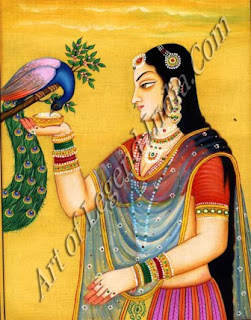 In the reign of Maharana
Sangram Singh (1710-1734) also this tradition went on quite ceaselessly. The
continuing tradition of Geet-Govind painting is linked with the 'Set' (bearing
the name of Roop Ji Bhatt Samvat 1771 A.D. 1714) available at Govt. Museum,
Udaipur. The important set of Bihari Sat Sai with Jagannath Kavi Raj's Colophon
(1719) is preserved at Saraswati Bhandar, Udaipur: In addition to these, a
number of group-paintings were also made. These paintings present life-like
depiction of feudal life.
In the reign of Maharana
Sangram Singh (1710-1734) also this tradition went on quite ceaselessly. The
continuing tradition of Geet-Govind painting is linked with the 'Set' (bearing
the name of Roop Ji Bhatt Samvat 1771 A.D. 1714) available at Govt. Museum,
Udaipur. The important set of Bihari Sat Sai with Jagannath Kavi Raj's Colophon
(1719) is preserved at Saraswati Bhandar, Udaipur: In addition to these, a
number of group-paintings were also made. These paintings present life-like
depiction of feudal life.
Even in the last phase of the
eighteenth century, the Mewari painting kept on displaying feudal grandeur
exemplified in the paintings of Jiwa, Nanga, Shahji, Miya, Shiva etc. preserved
in Palace Museum, Udaipur and the private museum of Kumar Sangram Singh.
At Nathdwara, the installation
of Shri Nathji gave rise to fresh dimensions in art. During the eighteenth and
the nineteenth centuries, the Mewar painting, imbibing the Brij and Mughal
influences, continued to manifest its rise and fall through epic-painting,
wall-painting and miniature painting.
Nathdwara
Substyle
 A distinct Mewar style of
painting is termed Nathdwara substyle. To avoid the oppression of Aurangzeb,
the image of Shri Nathji installed at Govardhan was brought to Rajasthan and
installed at Nathdwara in 1670. Along with Acharya Gopi Nathji, many artists
endowed with great religious fervour came here and created many beautiful
paintings of Shri Nathji.8 With the combination of the already established art
of Mewar and artists of Nathdwara, the Nathdwara style of painting emerged.
Many paintings concerning various lilas of Shri Nathji were created on paper or
cloth, and they are still available in various national and international
museums as well as many private collections.
A distinct Mewar style of
painting is termed Nathdwara substyle. To avoid the oppression of Aurangzeb,
the image of Shri Nathji installed at Govardhan was brought to Rajasthan and
installed at Nathdwara in 1670. Along with Acharya Gopi Nathji, many artists
endowed with great religious fervour came here and created many beautiful
paintings of Shri Nathji.8 With the combination of the already established art
of Mewar and artists of Nathdwara, the Nathdwara style of painting emerged.
Many paintings concerning various lilas of Shri Nathji were created on paper or
cloth, and they are still available in various national and international
museums as well as many private collections.
Behind the figures of Shri
Nathji, large screens of cloth are affixed to enhance their decorative aspect.
These are known as picchavais, and they are the original contribution of the
Nathdwara style. Picchapais are often created to symbolise any of these
concerning festivals and lilas of Shri Nathji. Even today, the tradition of Nathdwara
continues. Depiction of natural scenery from the 18th century to this date is a
distinct feature of the Nathdwara style.
The Nathdwara style continued
to achieve artistic beauty. In the period of Tilkya t Goverdhan Lallji,
painting of this style attained a pinnacle of glory. The main patrons of it
were those thousands of pilgrims and devotees of Shri Na thji who continued to
purchase paintings for the purpose of decoration.
 In the 18th century, owing to
the abundance of themes relating to the Was of Krishna in painting, subjects
like Mata Yasoda, Nandlal, cowherds were particularly painted. Because of the
impact of Balkrishna a sense of maturity appeared in the figures of females,
the physical profile and glimpses of sentiments of affection are particularly
noticeable. Among male subjects physically stout Nandlal and other Balgopal
figures call for special mention.
In the 18th century, owing to
the abundance of themes relating to the Was of Krishna in painting, subjects
like Mata Yasoda, Nandlal, cowherds were particularly painted. Because of the
impact of Balkrishna a sense of maturity appeared in the figures of females,
the physical profile and glimpses of sentiments of affection are particularly
noticeable. Among male subjects physically stout Nandlal and other Balgopal
figures call for special mention.
Cows, colts, boys, forest
creepers are special components painted in the Na th-dwara style. Because of
the overall impact of folk art, simplicity of subjects, rhythm and combination
of colours with distinct features had emerged in earlier paintings. About 200
years ago Shri Ram Chandra Baba, who came to Nathdwara from Jaipur, introduced
new elements in sketching trees in paintings of that style. The artist Bhagwa
ti had exhibited his skill in drawing minute details. The work of leading
artists like Narayan, Cha tu rbhuj, Ramlinga, Udai Ram also deserves special
reference.
In the 19th and 20th
centuries, with the development of commercial art in the Nathdwara style,
irregular colours and the growing impact of photography resulted in the
systematic downgrading of the art of this region. But the tradition of painting
in this style is still alive.
Devgarh
Substyle
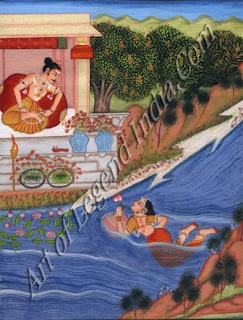 The Mewar School has been the
chief and basic school of Rajasthani painting, and as such it has also
influenced its nearby Thikanas in terms of drawing. The style of painting that
developed there has imbibed not only its original culture, but it also
remarkably manifests the stamp of natural environment, and the styles in vogue
around. From this viewpoint the paintings of Devgarh, Sawar, and Shahpura
Thikanas deserve a special note. These can be grouped under Mewar substyle.
The Mewar School has been the
chief and basic school of Rajasthani painting, and as such it has also
influenced its nearby Thikanas in terms of drawing. The style of painting that
developed there has imbibed not only its original culture, but it also
remarkably manifests the stamp of natural environment, and the styles in vogue
around. From this viewpoint the paintings of Devgarh, Sawar, and Shahpura
Thikanas deserve a special note. These can be grouped under Mewar substyle.
Located near the Marwar border,
Devgarh Thikana was established by Rawat Dwarkadas Chudawat in 1680 during the
reign of Maharana Jaisingh (1680-1698). Despite its adherence to the Mewar
painting tradition, the Devgarh painting-style displays naturally the impact of
Marwar. In 1728, the princess of Devgarh was married to Maharana Madho Singh of
Jaipur, and as such due to matrimonial, blood and cultural relations; and also
owing to the assimilation of the traits of Mewar, Marwar and Jaipur art, the
paintings prepared by the painters of this region have their own individual
identity. This style has acquired distinctiveness on account of the use of
thick and well-balanced lines, abundance of green and yellow colours unlike
Mewar, the folk painting of Marwar-like figures of men and women, natural
desert landscape, hunting, community feast (goth), harems, royal grandeur,
adornment, and carriages etc. On this basis it can be placed under Mewar
substyle.
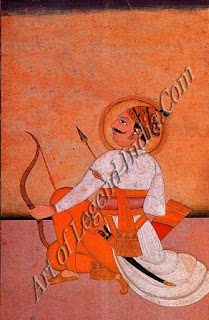 Devgarh paintings are preserved
in various museums and private collections, chief among which are National
Museum, New Delhi, Prince of Wales Museum, Bombay, Kumar Sangram Singh Museum,
Jaipur, Kawasji, Shri Suhali, Boman Behran, Bombay etc. Besides, important
Devgarh material is available at the per-sonal collection of Rawal Nahar Singh
of Devgarh. The wall-paintings at Kapardwar of Devgarh, Ajara Ki Ovari, Moti
Mahal, give us an idea of the tradition of painting here.
Devgarh paintings are preserved
in various museums and private collections, chief among which are National
Museum, New Delhi, Prince of Wales Museum, Bombay, Kumar Sangram Singh Museum,
Jaipur, Kawasji, Shri Suhali, Boman Behran, Bombay etc. Besides, important
Devgarh material is available at the per-sonal collection of Rawal Nahar Singh
of Devgarh. The wall-paintings at Kapardwar of Devgarh, Ajara Ki Ovari, Moti
Mahal, give us an idea of the tradition of painting here.
Among the Devgarh painters,
Bagata (1769-1820) and Kanwala I (1775-1810) were two distinguished artists.
Kanwala II (1800-1850), Chaukha and Baij Nath (1770-1830) following in the
footsteps of their above illustrious predecessors, en-riched the Devgarh
substyle by their valuable contribution. Dr Shridhar Andhare highlighted this
style for the first time.
Salient
Features
 Mewar painting possesses unique
features which greatly influenced the different styles of Rajasthani
painting." A synthesis of Jain and Gujarati styles is evident in the
earliest Mewar painting. Besides the simplicity of folk art, the irregularity
of line was a unique characteristic. But from the middle of the 17th
century the independent growth of this style became famous for its own inherent
qualities.
Mewar painting possesses unique
features which greatly influenced the different styles of Rajasthani
painting." A synthesis of Jain and Gujarati styles is evident in the
earliest Mewar painting. Besides the simplicity of folk art, the irregularity
of line was a unique characteristic. But from the middle of the 17th
century the independent growth of this style became famous for its own inherent
qualities.
Stout masculine figures, faces
covered with mustaches, wide eyes, open lips, small neck, long turban, waist
tied with dupatta and body decorated with general ornaments are some
distinctive features of the Mewar style. Paintings of females depict eyes
resembling those of a fish, a straight long nose, double chins, short stature,
body covered with ghagara-luggri and kartchuki and Rajasthani ornaments.
Careful drawing of nature is
visible in the Mewar School. Among birds, chakor, hails, peacock, and among
animals horse, elephant, deer, lion were frequently painted. The impact of the
Malwa school is visible in the paintings of nature. In Mewar paintings, where
colours maintain their own simplicity, most paintings have been drawn upon red,
yellow and green surfaces. An artistic display of folk colours is a unique
tradition of Mewar paintings.
Writer
– Jay Singh Neeraj
 From the point of view of
historical traditions in Rajasthani painting the Mewar school occupies first
place. The artistic heritage of Medpat, the land of Guhil rulers, was a
perennial source of inspiration for ancient and other schools of art. Paintings
of Mewar earned wide publicity among other styles and substyles, and paintings
of the Udaipur, Nathdwara and Devgarh styles are immortal legacies of this
school.
From the point of view of
historical traditions in Rajasthani painting the Mewar school occupies first
place. The artistic heritage of Medpat, the land of Guhil rulers, was a
perennial source of inspiration for ancient and other schools of art. Paintings
of Mewar earned wide publicity among other styles and substyles, and paintings
of the Udaipur, Nathdwara and Devgarh styles are immortal legacies of this
school.
 King Rana Kumbha (1443-1468)
was a keen student of architecture, literature, music and the other arts. That
this ruler was indifferent to painting is a view that does not seem acceptable,
but the history of painting in the 15th century remains in oblivion.
Rana Sanga (1509-1520) spent his life waging wars against the Mughal ruler
Babar.
King Rana Kumbha (1443-1468)
was a keen student of architecture, literature, music and the other arts. That
this ruler was indifferent to painting is a view that does not seem acceptable,
but the history of painting in the 15th century remains in oblivion.
Rana Sanga (1509-1520) spent his life waging wars against the Mughal ruler
Babar. From these facts, the role of
Mewar in developing Rajasthani art from its very beginning is abundantly clear.
On the basis of researches, the first example of the Mewar style is the
pictorial text titled Shravak Pratikraman Churni, which was painted in Adhar
(Ahar-Udaipur) in 1260 in the reign of Guhil Tej Singh.2 Its decoration
resembles the intricate artistic workmanship of temples dedicated to Mokul in
Nagda, Udaipur and Chittor.
From these facts, the role of
Mewar in developing Rajasthani art from its very beginning is abundantly clear.
On the basis of researches, the first example of the Mewar style is the
pictorial text titled Shravak Pratikraman Churni, which was painted in Adhar
(Ahar-Udaipur) in 1260 in the reign of Guhil Tej Singh.2 Its decoration
resembles the intricate artistic workmanship of temples dedicated to Mokul in
Nagda, Udaipur and Chittor.  Painting Many pictorial texts
painted in the Mewar style in the middle of the 17th century and in the reign
of Maharana Jagat Singh (1628-52) are available. Because of the growth of the
Vallabha sect in Rajasthan, the Radha-Krishna Lila was the main contribution of
the Mewar style. Hence Bhagwad-Puran was the main subject of painting. In the
text of Bhagwad-Puran painted by Sahabadi (1648) and preserved in the
Bhandarkar Institute, Pune, the Maharaja of Jodhpur Museum and the National
Museum, fine examples of the Mewar style are available.
Painting Many pictorial texts
painted in the Mewar style in the middle of the 17th century and in the reign
of Maharana Jagat Singh (1628-52) are available. Because of the growth of the
Vallabha sect in Rajasthan, the Radha-Krishna Lila was the main contribution of
the Mewar style. Hence Bhagwad-Puran was the main subject of painting. In the
text of Bhagwad-Puran painted by Sahabadi (1648) and preserved in the
Bhandarkar Institute, Pune, the Maharaja of Jodhpur Museum and the National
Museum, fine examples of the Mewar style are available.  Maharana Raj Singh (1652-1681)
also maintained the tradition of his father. During his period, paintings based
on a number of Sanskrit-writings, books of Bliakti and Ritikaleen periods were
made in abundance. The paintings of Shukar Kshatra Mahatinnya made by the
famous painter Sahi Badeen in 1655 and Bhramar Geet Stir in 1659, a few leaves
of which are preserved in the National Museum, New Delhi, hint at the evolution
of Mewar style. A few pages of Geet Govind set painted during this period,
preserved in Govt. Museum, Udaipur, are exceedingly artistic.
Maharana Raj Singh (1652-1681)
also maintained the tradition of his father. During his period, paintings based
on a number of Sanskrit-writings, books of Bliakti and Ritikaleen periods were
made in abundance. The paintings of Shukar Kshatra Mahatinnya made by the
famous painter Sahi Badeen in 1655 and Bhramar Geet Stir in 1659, a few leaves
of which are preserved in the National Museum, New Delhi, hint at the evolution
of Mewar style. A few pages of Geet Govind set painted during this period,
preserved in Govt. Museum, Udaipur, are exceedingly artistic.  In the reign of Maharana
Sangram Singh (1710-1734) also this tradition went on quite ceaselessly. The
continuing tradition of Geet-Govind painting is linked with the 'Set' (bearing
the name of Roop Ji Bhatt Samvat 1771 A.D. 1714) available at Govt. Museum,
Udaipur. The important set of Bihari Sat Sai with Jagannath Kavi Raj's Colophon
(1719) is preserved at Saraswati Bhandar, Udaipur: In addition to these, a
number of group-paintings were also made. These paintings present life-like
depiction of feudal life.
In the reign of Maharana
Sangram Singh (1710-1734) also this tradition went on quite ceaselessly. The
continuing tradition of Geet-Govind painting is linked with the 'Set' (bearing
the name of Roop Ji Bhatt Samvat 1771 A.D. 1714) available at Govt. Museum,
Udaipur. The important set of Bihari Sat Sai with Jagannath Kavi Raj's Colophon
(1719) is preserved at Saraswati Bhandar, Udaipur: In addition to these, a
number of group-paintings were also made. These paintings present life-like
depiction of feudal life.  A distinct Mewar style of
painting is termed Nathdwara substyle. To avoid the oppression of Aurangzeb,
the image of Shri Nathji installed at Govardhan was brought to Rajasthan and
installed at Nathdwara in 1670. Along with Acharya Gopi Nathji, many artists
endowed with great religious fervour came here and created many beautiful
paintings of Shri Nathji.8 With the combination of the already established art
of Mewar and artists of Nathdwara, the Nathdwara style of painting emerged.
Many paintings concerning various lilas of Shri Nathji were created on paper or
cloth, and they are still available in various national and international
museums as well as many private collections.
A distinct Mewar style of
painting is termed Nathdwara substyle. To avoid the oppression of Aurangzeb,
the image of Shri Nathji installed at Govardhan was brought to Rajasthan and
installed at Nathdwara in 1670. Along with Acharya Gopi Nathji, many artists
endowed with great religious fervour came here and created many beautiful
paintings of Shri Nathji.8 With the combination of the already established art
of Mewar and artists of Nathdwara, the Nathdwara style of painting emerged.
Many paintings concerning various lilas of Shri Nathji were created on paper or
cloth, and they are still available in various national and international
museums as well as many private collections.  In the 18th century, owing to
the abundance of themes relating to the Was of Krishna in painting, subjects
like Mata Yasoda, Nandlal, cowherds were particularly painted. Because of the
impact of Balkrishna a sense of maturity appeared in the figures of females,
the physical profile and glimpses of sentiments of affection are particularly
noticeable. Among male subjects physically stout Nandlal and other Balgopal
figures call for special mention.
In the 18th century, owing to
the abundance of themes relating to the Was of Krishna in painting, subjects
like Mata Yasoda, Nandlal, cowherds were particularly painted. Because of the
impact of Balkrishna a sense of maturity appeared in the figures of females,
the physical profile and glimpses of sentiments of affection are particularly
noticeable. Among male subjects physically stout Nandlal and other Balgopal
figures call for special mention.  The Mewar School has been the
chief and basic school of Rajasthani painting, and as such it has also
influenced its nearby Thikanas in terms of drawing. The style of painting that
developed there has imbibed not only its original culture, but it also
remarkably manifests the stamp of natural environment, and the styles in vogue
around. From this viewpoint the paintings of Devgarh, Sawar, and Shahpura
Thikanas deserve a special note. These can be grouped under Mewar substyle.
The Mewar School has been the
chief and basic school of Rajasthani painting, and as such it has also
influenced its nearby Thikanas in terms of drawing. The style of painting that
developed there has imbibed not only its original culture, but it also
remarkably manifests the stamp of natural environment, and the styles in vogue
around. From this viewpoint the paintings of Devgarh, Sawar, and Shahpura
Thikanas deserve a special note. These can be grouped under Mewar substyle. Devgarh paintings are preserved
in various museums and private collections, chief among which are National
Museum, New Delhi, Prince of Wales Museum, Bombay, Kumar Sangram Singh Museum,
Jaipur, Kawasji, Shri Suhali, Boman Behran, Bombay etc. Besides, important
Devgarh material is available at the per-sonal collection of Rawal Nahar Singh
of Devgarh. The wall-paintings at Kapardwar of Devgarh, Ajara Ki Ovari, Moti
Mahal, give us an idea of the tradition of painting here.
Devgarh paintings are preserved
in various museums and private collections, chief among which are National
Museum, New Delhi, Prince of Wales Museum, Bombay, Kumar Sangram Singh Museum,
Jaipur, Kawasji, Shri Suhali, Boman Behran, Bombay etc. Besides, important
Devgarh material is available at the per-sonal collection of Rawal Nahar Singh
of Devgarh. The wall-paintings at Kapardwar of Devgarh, Ajara Ki Ovari, Moti
Mahal, give us an idea of the tradition of painting here.  Mewar painting possesses unique
features which greatly influenced the different styles of Rajasthani
painting." A synthesis of Jain and Gujarati styles is evident in the
earliest Mewar painting. Besides the simplicity of folk art, the irregularity
of line was a unique characteristic. But from the middle of the 17th
century the independent growth of this style became famous for its own inherent
qualities.
Mewar painting possesses unique
features which greatly influenced the different styles of Rajasthani
painting." A synthesis of Jain and Gujarati styles is evident in the
earliest Mewar painting. Besides the simplicity of folk art, the irregularity
of line was a unique characteristic. But from the middle of the 17th
century the independent growth of this style became famous for its own inherent
qualities. 










Thanks for sharing about Traditional Painting. Your content is realy informative for us......
Indian Traditional Paintings
Indian Painting
Traditional Paintings
Traditional Painting
Indian Traditional Painting
Traditional Paintings
Traditional Painting